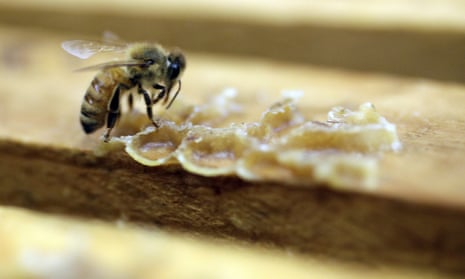Beekeepers across the US lost four in 10 of their honeybee colonies over the past year, as the worst winter on record for tracked bee populations raised fresh concerns over the plight of the crucial pollinators.
Over the past winter, 37% of honeybee colonies were lost to beekeepers, the worst winter decline recorded in the 13-year history of a nationwide survey aimed at charting bees’ fortunes. Overall, 40% of colonies died off over the entire year to April, which is above the 38% average since the survey began.
Researchers said the numbers were concerning given the intensive efforts to stem the loss of honeybees, which pollinate an estimated $15bn in US crops each year, enabling the farming of foods including apples, melons, cherries, almonds and blueberries.
Alarm over honeybee numbers has grown since 2006, when a phenomenon called colony collapse disorder became widely known. This problem, in which the majority of worker bees abandon the colony, has since receded but beekeepers are now faced with more general die-offs linked to disease, pesticide use and habitat loss.
“It’s disconcerting that we’re still seeing elevated losses after over a decade of survey and quite intense work to try to understand and reduce colony loss,” said Geoffrey Williams, assistant professor of entomology at Auburn University.
“We don’t seem to be making particularly great progress to reduce overall losses.”
Williams is a co-author of the annual honeybee survey conducted by the Bee Informed Partnership, a not-for-profit group led by the University of Maryland. The survey has been conducted since 2006 as part of a broad effort by researchers, beekeepers and the US government to understand and reverse colony loss.
In response to the widespread losses during wintertime, beekeepers have been splitting healthy colonies to duplicate them. This results in a spike in colony numbers in summer, only for major crashes to occur in winter.
The latest survey included data from 4,700 beekeepers from all 50 states, capturing about 12% of the US’s estimated 2.69m managed colonies. Researchers behind the survey say it’s in line with findings from the US Department of Agriculture, which keeps data on the remaining colonies.
Honeybees are an introduced species to the US and are intensively managed for their pollination services. The bees are routinely packed in trucks and sent to hotspots such as California to help cultivate crops, such as almonds, that are entirely dependent upon them to propagate.
Native wild bee species, such as the American bumblebee, are also thought to be in sharp decline. The troubles faced by bees are part of a broader trend of stunning drops in insect abundance around the world, although the exact contours of this crisis are obscured by a lack of data in many places.
The entomologists behind the Bee Informed Partnership said a number of factors were likely to have caused the deepening losses of colonies, including varroa mites, which are lethal parasites that have been spreading for several years in the US.
“We are increasingly concerned about varroa mites and the viruses they spread,” said Dennis vanEngelsdorp, an entomologist at the University of Maryland and president of the Bee Informed Partnership.
VanEngelsdorp said that the products used by beekeepers to remove the mites seemed to be becoming less effective.
As bee-friendly habitat is razed and turned into monocultural farms and housing, bees are deprived of nutrition-rich pollen sources and exposed to a range of potentially harmful pesticides. A growing concern is the role of climate change, with rising global temperatures and increasingly extreme weather events, such as wildfires and storms, posing a looming threat.
“Beekeepers have to be very dynamic in their response to weather and environmental conditions,” said Williams.
“If it is a cold, long winter, beekeepers need to be very diligent and make sure they have enough food for their bees to survive. On the other hand, warm winters can create favorable conditions for varroa mites, which means beekeepers need to know how to manage them properly.”
